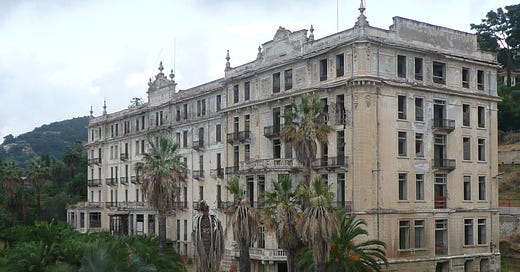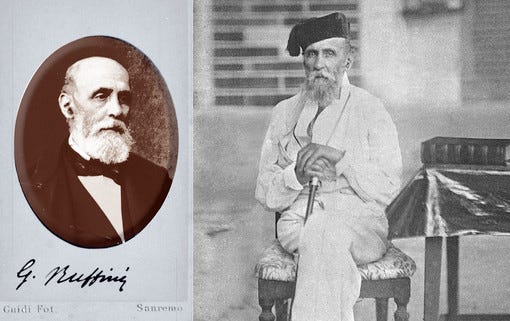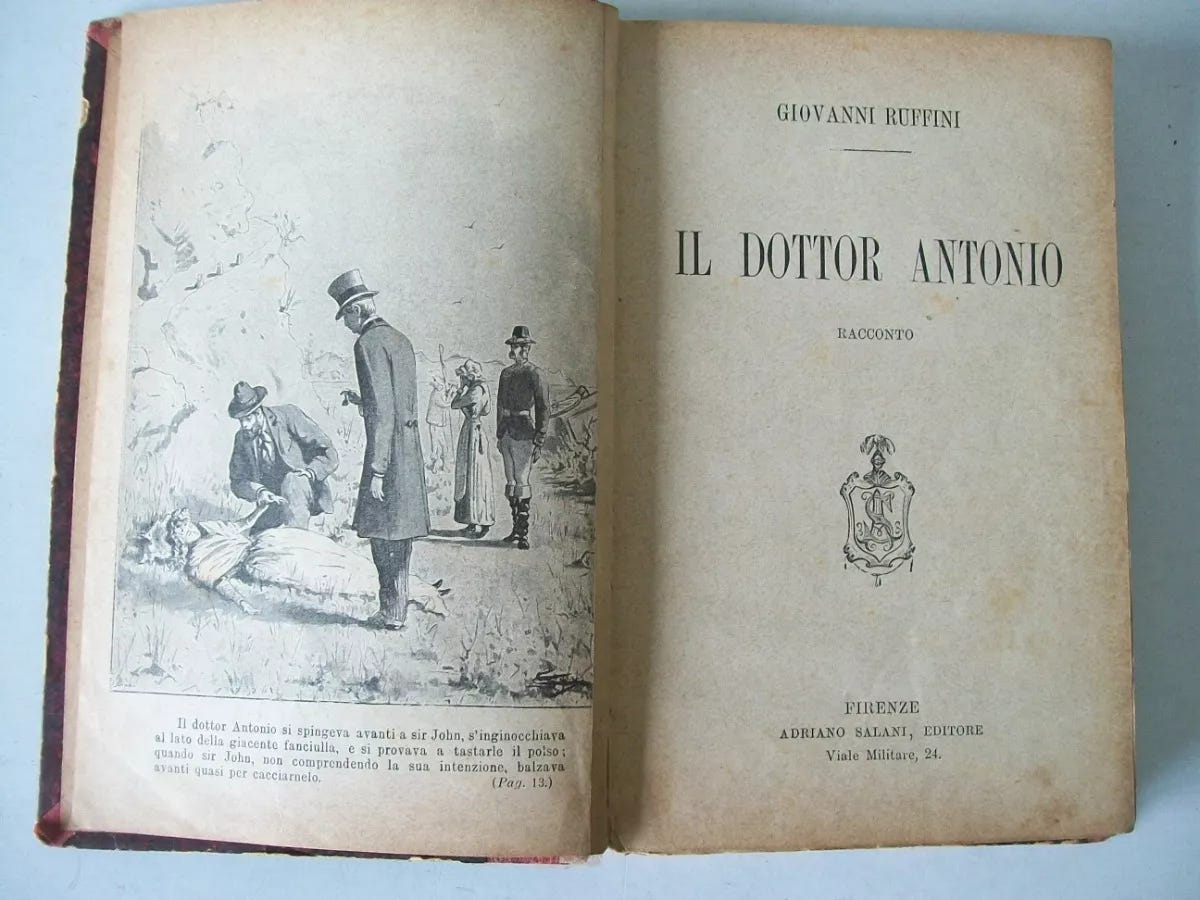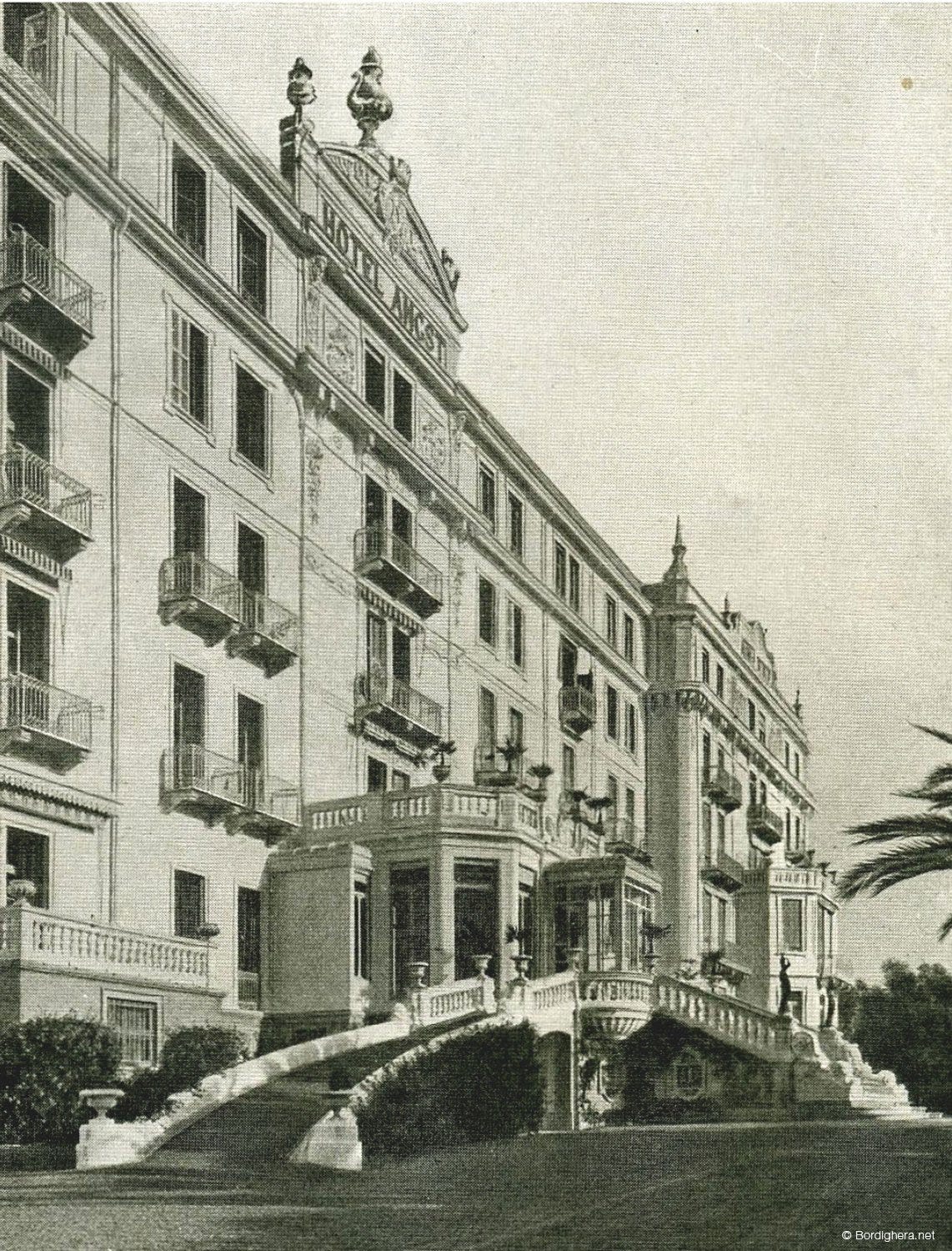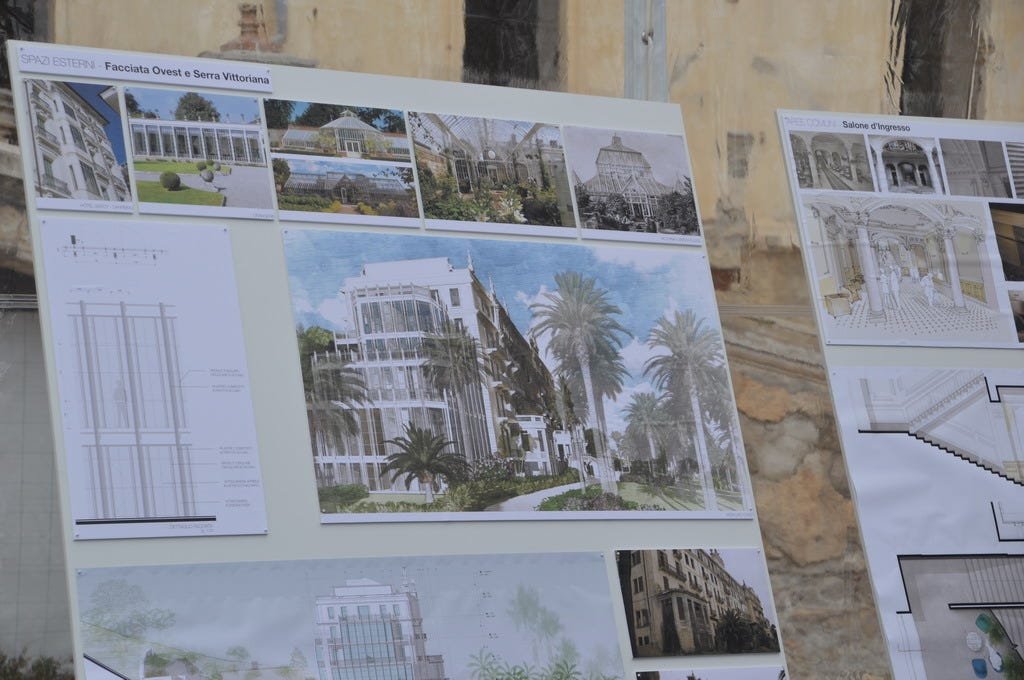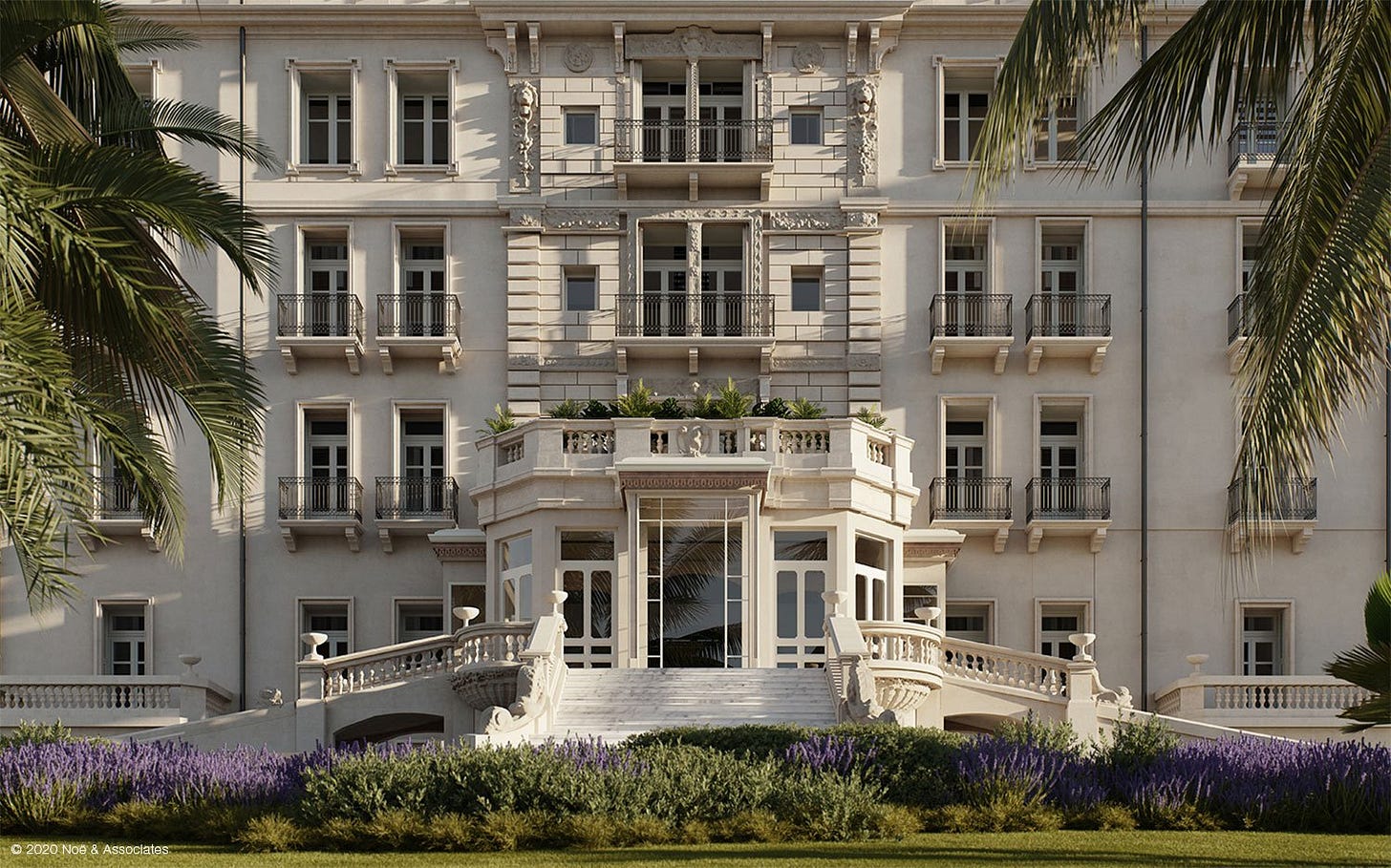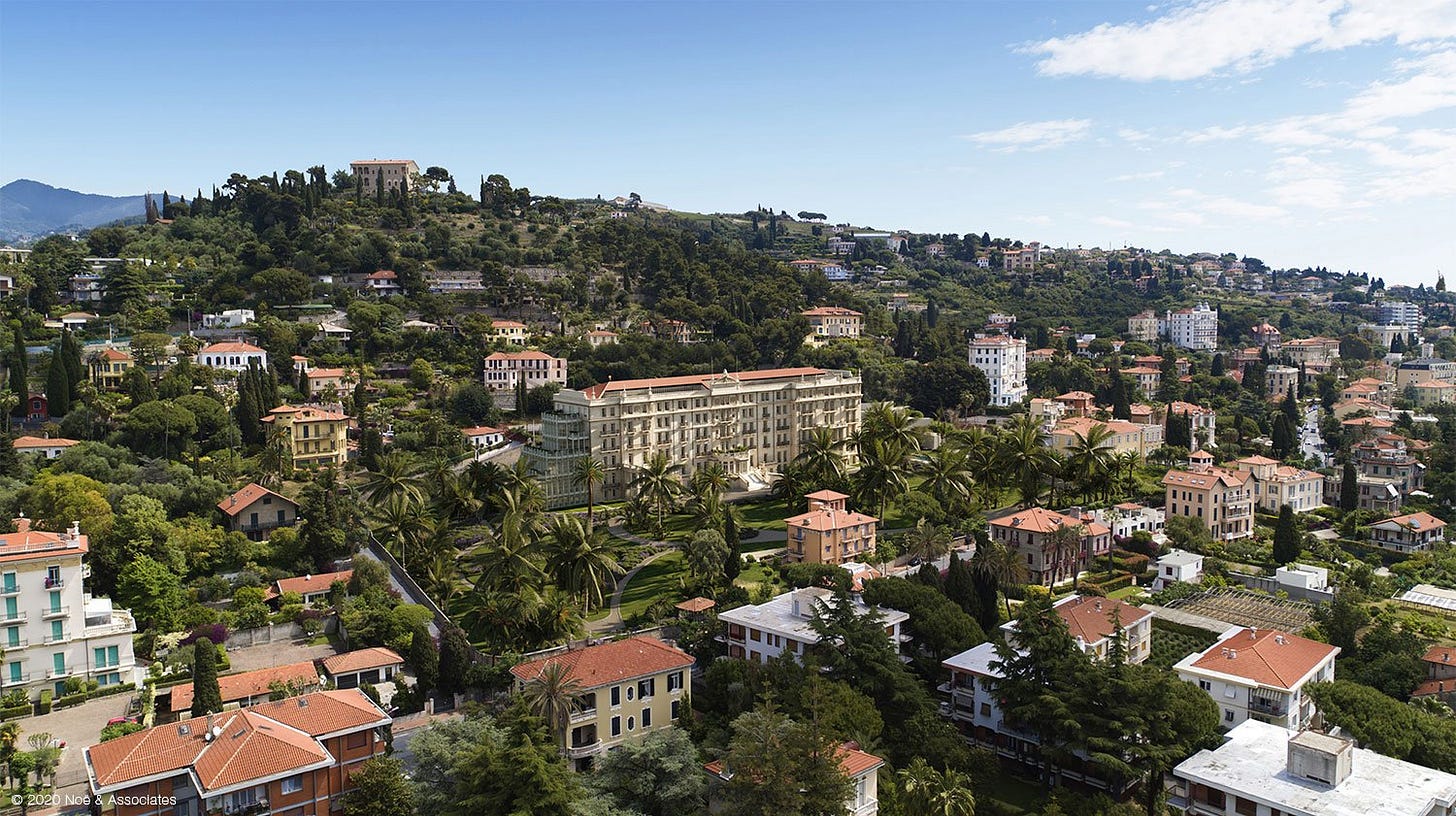💚🤍❤️ The Fascinating History of Hotel Angst
A look into the iconic hotel's past and present on the Italian Riviera.
Welcome to this new edition of my Liguria Letters. Today we travel to Bordighera and find out about the history of one of its oldest former hotels with an intriguing name: the hotel Angst
In recent years, the Hotel Angst at Via Romana 76 in Bordighera on the Riviera dei Fiori in Liguria Ponente has been a unique tourist attraction due to its remarkable architecture and rich history. Although the monumental building had been neglected for years, visitors still flocked to take pictures of it. The hotel has even gained global attention from YouTubers, who have climbed over the barriers to make exciting videos of the dilapidated building for the internet. You can find a link to one of these videos at the bottom of this page.
Since 1985, Hotel Angst has been part of the Soprintendenza ai Beni Culturali, the Italian monument conservation. Despite its state of disrepair, the original nameplate serves as a reminder of the grandeur it once possessed.
All in all, reason enough for me to want to know more about this exceptional hotel and its history ...
As I read about its founder, Adolf Angst (1847-1924), and look at vintage photos of the building, I can't help but be reminded of a scene from The Shining, a horror movie directed by Stanley Kubrick in 1980, based on a book by Stephen King published in 1977.
For those of you who don’t know the story, it tells about Jack Torrance (the main character, played by Jack Nicholson), who manages a hotel located in the remote Colorado Rocky Mountains and in this completely isolated environment, cut off from the outside world, gradually loses touch with reality. His son, Danny, is gifted with telepathic abilities, which allow him to see the hotel's horrific past and various ghostly apparitions, providing viewers with a glimpse into the hotel's eerie history.
Spooky tales about the Hotel Angst are also a popular topic among the residents of Bordighera, like the ones told by guests who have seen the ghost of a young woman wandering the hotel at night.
How did these stories come to be? To find out, we must explore the history of tourism in Bordighera during the nineteenth century:
In Victorian times, Bordighera became a popular destination to visit among affluent Englishmen who created their own British centre in the alluring seaside resort. This was largely due to Giovanni Ruffini's novel Il Doctor Antonio, first published in Edinburgh in 1855. Ruffini (1807-1881), was an Italian writer and patriot who sought support for the unification of Italy. The novel is set during the Risorgimento, a period of political upheaval during this process in Italy between 1830 and 1870. It tells the story of the impossible love between dott. Antonio, a Sicilian revolutionary, and Lucy, the daughter of English aristocrat Sir John Davenne.
La Storia:
On a beautiful spring day, Sir John Davenne and his young daughter Lucy travel to Nice. Just before they arrive in Bordighera, the horses bolt, and the carriage crashes. Lucy has a broken leg but is saved by dott. Antonio, who speaks English. This young doctor arranged for Lucy to be transported to the nearest inn, the Osteria del Mattone, where she stayed for several weeks.
Between Lucy and dott. Antonio blossom feelings that are not expressed because a relationship between the two is not accepted within the prevailing social conventions.
When Lucy recovers, she returns to England and marries the man chosen for her by the family. This husband dies after only a few years, and Lucy, now widowed, returns to Bordighera in search of her Antonio. In the rebellious time of 1848, she even follows him to Napoli but finds her lover arrested for his political views and imprisoned on the Isola d'Ischia, an island off the coast in the Golfo di Napoli. The fragile Lucy eventually dies of heartache because she has not been able to save the man she loved.
Ruffini's vivid descriptions of Bordighera and the Mediterranean landscape of Liguria were so captivating that they inspired many English people to visit the region and witness the beauty of the places the author wrote about in his novel firsthand.
In addition to English visitors, other foreigners began to discover the Italian Riviera, including the wealthy Austrian entrepreneur Adolf Angst who had the ambition to build the most prestigious six-star luxury hotel ever. He is also very impressed by the beauty of the nature around Bordighera, the azure blue sea, and the magical atmosphere and decides to make his dream come true there. Soon, he finds a large piece of land to realise the plans. Still, there is a problem: on this land is the house of a certain Signora Ghella, and to start the construction, her home has to be demolished, but this lady does not want to sell. After a legal battle over the ownership of the land, it was eventually destroyed by a mysterious fire that killed her. Her body has never been found. . .
From the opening of the Hotel Angst in 1887, all kinds of ghostly stories have arisen in tradition, which, as is the case with this type of story, have become more and more exciting, especially about the nocturnal visits of a ghost who wanders the corridors of the hotel at night, of which hotel guests even describe the rustling of her skirts.
Could this be the ghostly apparition of Signora Ghella . .?
At the beginning of the 19th century, Hotel Angst exudes all the elegance and grandeur typical of the Belle Epoque: a large driveway with an exotic palm garden all around leads to the stairs of an enormous landing and the entrance. There are several beautiful salons, a ladies' lounge, a smoking area for the gentlemen, and a library.
The rooms with baths have running water and electricity, which is very modern. Bridge, chess, and tennis are played, and concerts, balls, Thé dansants, and cultural activities are organised. The restaurant is staffed by a brigade of the best-trained chefs who create culinary specialities for the guests who appear in evening gowns and jackets.
In addition to well-to-do English and Germans, French people, such as the artist Claude Monet, also spend their holidays in the hotel. Royalty, such as Queen Victoria of England, for example, has had plans to stay; the queen rents the entire hotel for herself and her staff, but in the end, unfortunately for Bordighera, she has to cancel due to the outbreak of the Boer War.
Adolf Angst has been important for Bordighera. The philanthropist brought employment for the inhabitants and has donated to various institutions, making him an honorary citizen of Bordighera and receiving the Croce di Cavaliere della Corona d'Italia, an Italian royal decoration, for his efforts.
Next to glorious times, the hotel has also seen bad times; in 1887 the first construction planned in Piazza della Stazione was destroyed by an earthquake. However, this did not discourage Angst because he reopened his hotel on Via Romana that same year. During the First World War, the building was used as a military hospital.
After Angst died, Max Naudenbousch, the husband of his daughter Maria, took over the management of the hotel, but in the aftermath of the First World War, the well-to-do and aristocratic foreign tourists no longer came, and those who did make reservations in less dated hotels. During the Second World War, Mussolini is said to have organised a dinner at the hotel for General Franco at Hitler's insistence, but after this event, it quickly fell into disrepair. After the hotel's closure in 1946, doors and window frames were used as fuel, and a lot was stolen, from marble to lamps and its decorations destroyed.
In 2018, the municipality of Bordighera set up a new plan for hotel Angst in collaboration with project developer Bizzi & Partners Development S.p.A. After the official presentation of the building plans, with the laying of the foundation stone by the then mayor Giacomo Pallanca of Bordighera, this project started.
Based on the creative ideas of Susanna Scarabicchi, of the architectural firm Tectoo, and the implementation by engineer Giuseppe Bessone, Hotel Angst has now been converted into a pretentious apartment complex in which the classic façade and typical style elements of the monumental building have been preserved.
Very luxurious apartments have been created, with a private garage, multiple communal areas, and two swimming pools. In addition, the park around the hotel has been redesigned by landscape architects who, as in the original design, have incorporated palm and olive trees that refer to the exotic atmosphere of earlier times.
With this extensive restoration of the former hotel Angst, the municipality of Bordighera has contributed to cultural preservation, attracted investors, and created employment. Future apartment owners will enjoy restaurants and shops in the Città delle Palme, the City of the Palm trees, as Bordighera is also known, and contribute to its economy. Even if a six-star luxurious lifestyle is not for you, it is nice to visit this historic place in Bordighera and know the story behind it...
💚🤍❤️
Source:
Lucia Baudo, Il ritorno del Dottor Antonio, articolo pubblicato su “Provincia di Imperia” numero 83/84, anno 2000.
Websites:

